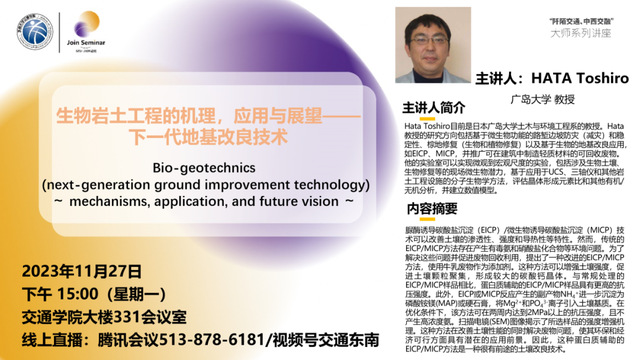
TOPIC INTRODUCTION
Enzyme-induced carbonate precipitation (EICP) / Microbially induced carbonate precipitation (MICP) represent innovative ground improvement techniques that enhance soil properties under ambient conditions, including permeability, strength, and thermal conductivity. This lecture delves into the underlying chemical mechanisms of conventional EICP/MICP techniques, primarily driven by urea hydrolysis reactions. While conventional EICP/MICP techniques offer promising ground improvement potential, they produce bicarbonate and ammonia, posing environmental concerns due to their toxicity to biota. Moreover, the ammonia generated undergoes degradation by nitrifying bacteria, leading to the formation of nitric/nitrogen acid, another biota-toxic substance to the environment and natural eco-system. To address these environmental concerns and promote waste recycling, the authors propose a modified EICP/MICP approach. This modified method utilizes bovine milk waste, a rich source of unique proteins, as an additional substance. These proteins enhance UCS strength, facilitate soil particle bonding, and promote the formation of large calcium carbonate crystals. Compared to conventional EICP-treated ones, the protein-assisted EICP/MICP samples exhibit significantly increased compressive strength. Additionally, the EICP or MICP reaction produces byproducts, notably NH4+, which further precipitate as magnesium ammonium phosphate (MAP) or struvite, introducing Mg2+ and PO43- ions into the soil matrix. Under optimized conditions, the proposed method can achieve compressive strengths exceeding 2 MPa within two weeks of curing, without generating high concentrations of ammonium. Scanning electron microscopy (SEM) images of selected samples reveal the distinct strength enhancement mechanisms associated with the protein-assisted EICP/MICP treatments under the proposed method. The alkaline environment induced by ammonium ions from urea hydrolysis facilitates the dissolution of proteins into pore water. This dissolved protein, along with the presence of NH4+, contributes to a more viscous pore water, which enhances the retention of calcium carbonate and struvite crystals on particle surfaces or soil voids. This phenomenon leads to the combined binding and growth of calcium carbonate and struvite crystals within the soil pores, resulting in significant strength improvements. This study demonstrates that the proposed methods as efficient assisting agents for EICP/MICP treatment, offering reduced environmental impacts compared to conventional EICP/MICP approaches. And more, the authors envision a future of next-generation bio-based geotechnics that eliminate toxic byproducts and promote carbon capture and storage through bio-reactions, such as the utilization of CA enzymes for calcium carbonate crystal formation.
ABOUT THE SPEAKER
Toshiro Hata is currently a professor in the Department of Civil and Environmental Engineering at Hiroshima University, Hiroshima, Japan. Professor Hata’s research activities include disaster prevention(mitigation) and stability of cut slopes based on microbial functions, brownfield rehabilitation (Bio and Phyto remediation), and Bio-based ground improvement application such as EICP, MICP and promote the recycled waste which create the lightweight materials in constructions. His laboratory can apply the micro to macro scale experiments, including the In-site microbe potentials which involved Bio-soil, Bioremediation etc, based on the molecule biological methods Applied to the UCS, Tri-axial cell, and other geotechnical facilities, evaluate the crystal formation element ratio and other organic/inorganic analysis, and develop the numerical model.